Tissue Science: Immunohistochemical Method for EBV Detection
VerifiedAdded on 2023/05/28
|12
|2610
|319
Essay
AI Summary
This essay details the development of an immunohistochemical (IHC) method for identifying Epstein-Barr virus (EBV) in tonsil tissue. The introduction provides an overview of IHC and the biology of EBV, including its pathogenesis and significance. The main body outlines the step-by-step process, including tissue processing stages such as fixation using acetone and alcohol via immersion, antigen retrieval methods (HIER and PIER), choice of primary antibodies (monoclonal vs. polyclonal), detection systems (immunofluorescence), and the inclusion of appropriate controls (positive and negative). The essay then discusses the interpretation of results, including morphological parameters and qualitative scoring. The conclusion evaluates the pros and cons of the chosen method, highlighting its ability to detect tumor metastasis and infectious agents, while also acknowledging its lower sensitivity and susceptibility to photobleaching. The essay also mentions current advancements in EBV detection and is formatted with Harvard referencing, as per the assignment brief provided. The essay is a comprehensive guide to developing and implementing an IHC method for EBV detection in tissue samples.

Tissue science:
Student name:
Institutional affiliation:
Student name:
Institutional affiliation:
Paraphrase This Document
Need a fresh take? Get an instant paraphrase of this document with our AI Paraphraser

Introduction
Overview of ICC/IHC
Immunohistochemistry (IHC) is a process that involves imaging antigens present in the cells of
tissue section by making use of the principle of specific antigens in tissues of living organisms
being bound by antibodies (Beach.et.al 2018, pp.793-802). This staining is commonly considered
in diagnosis of abnormal cells such as cancer cells in cancerous tumors. Epstein-Barr virus also
known as human herpes virus 4 is commonly cause infectious mononucleosis. Epstein-Barr virus
raises the risk of getting nasopharyngeal cancer and lymphomas such as Burkitt lymphoma.
These are some of cancer that grow fast and are painless sometimes. They are most common in
young children. It can also be linked to Hodgkin lymphoma and some stomach cancer.
Biology of Epstein-Barr virus
According to Allday, Bazot and White (2015, pp.61-117), Epstein-Barr virus remains in the body
of an organism for long period of time. It persists in an inactive state in resting memory B
lymphocytes in human being for lifetime. This virus persists by changing the normal cell biology
of B cells hence changing its morphology. This comprises the virus going through a cycle of
infected stages whereby every stage encompasses viral gene transcription program. The virus
that is infectious get into the Waldeyer’s ring’s lymphoid tissue and then penetrates the epithelial
barrier to infect naive B cells directly making them active. This proliferate the latently infected
blasts showing all nine latent proteins that are known. These cells then go to the germinal center
so as to participate in the germinal center reaction. They produce more restricted pattern of latent
proteins at this stage. These cells finally leave as latently infected memory B cells which can
only express viral genome tethering protein or no viral protein at all. The virus resides here
Overview of ICC/IHC
Immunohistochemistry (IHC) is a process that involves imaging antigens present in the cells of
tissue section by making use of the principle of specific antigens in tissues of living organisms
being bound by antibodies (Beach.et.al 2018, pp.793-802). This staining is commonly considered
in diagnosis of abnormal cells such as cancer cells in cancerous tumors. Epstein-Barr virus also
known as human herpes virus 4 is commonly cause infectious mononucleosis. Epstein-Barr virus
raises the risk of getting nasopharyngeal cancer and lymphomas such as Burkitt lymphoma.
These are some of cancer that grow fast and are painless sometimes. They are most common in
young children. It can also be linked to Hodgkin lymphoma and some stomach cancer.
Biology of Epstein-Barr virus
According to Allday, Bazot and White (2015, pp.61-117), Epstein-Barr virus remains in the body
of an organism for long period of time. It persists in an inactive state in resting memory B
lymphocytes in human being for lifetime. This virus persists by changing the normal cell biology
of B cells hence changing its morphology. This comprises the virus going through a cycle of
infected stages whereby every stage encompasses viral gene transcription program. The virus
that is infectious get into the Waldeyer’s ring’s lymphoid tissue and then penetrates the epithelial
barrier to infect naive B cells directly making them active. This proliferate the latently infected
blasts showing all nine latent proteins that are known. These cells then go to the germinal center
so as to participate in the germinal center reaction. They produce more restricted pattern of latent
proteins at this stage. These cells finally leave as latently infected memory B cells which can
only express viral genome tethering protein or no viral protein at all. The virus resides here

inactively and it occasionally becomes reactivated to infect new B cells. Initiates lytic
reactivation is initiated by a small subset of latently infected memory B cells in association with
terminal differentiation signals. Reactivation takes place through expression of transcription
factors initiating viral replication then production of proteins involved in viral replication and
finally assembling of viral DNA and structural proteins. Epstein-Barr virus-transformed human
B lymphocytes present antigen to activated T cells. They present using MHC molecules that can
only be recognized by T cells. They therefore secrete detectable IL 1 (Veroni et.al 2018, p.18.)
Significance of detecting EBV
It is important to detect Epstein-Barr virus in individuals as it is known to cause infectious
mononucleosis. It also increases the risk of certain lymphomas such as Burkit lymphomas.
Immunohistochemical method
Receipt of request
Method of fixation
According to Hassani and Khan (2015, pp.558-563), tissue fixation is done to prevent putridness,
endogenic and exogenic enzyme activity. It also prevents postmortem autolysis, keeps cells and
tissue shape intact and prevents cells from shrinking and swelling. Commonly used fixing
solutions are acetone and alcohol. These are the primary solutions for fixing and functions to
precipitate sugars and fats. They also maintain the immunologic competence. Low molecular
weight protein, cytoplasmic proteins and polypeptide can be maintained effectively by alcohol. It
can also be combined with formalin. Acetone is often used due o its strong penetrability
dehydration property. The method preferred is immersion method. The tissue in fixing solution is
reactivation is initiated by a small subset of latently infected memory B cells in association with
terminal differentiation signals. Reactivation takes place through expression of transcription
factors initiating viral replication then production of proteins involved in viral replication and
finally assembling of viral DNA and structural proteins. Epstein-Barr virus-transformed human
B lymphocytes present antigen to activated T cells. They present using MHC molecules that can
only be recognized by T cells. They therefore secrete detectable IL 1 (Veroni et.al 2018, p.18.)
Significance of detecting EBV
It is important to detect Epstein-Barr virus in individuals as it is known to cause infectious
mononucleosis. It also increases the risk of certain lymphomas such as Burkit lymphomas.
Immunohistochemical method
Receipt of request
Method of fixation
According to Hassani and Khan (2015, pp.558-563), tissue fixation is done to prevent putridness,
endogenic and exogenic enzyme activity. It also prevents postmortem autolysis, keeps cells and
tissue shape intact and prevents cells from shrinking and swelling. Commonly used fixing
solutions are acetone and alcohol. These are the primary solutions for fixing and functions to
precipitate sugars and fats. They also maintain the immunologic competence. Low molecular
weight protein, cytoplasmic proteins and polypeptide can be maintained effectively by alcohol. It
can also be combined with formalin. Acetone is often used due o its strong penetrability
dehydration property. The method preferred is immersion method. The tissue in fixing solution is
⊘ This is a preview!⊘
Do you want full access?
Subscribe today to unlock all pages.

Trusted by 1+ million students worldwide
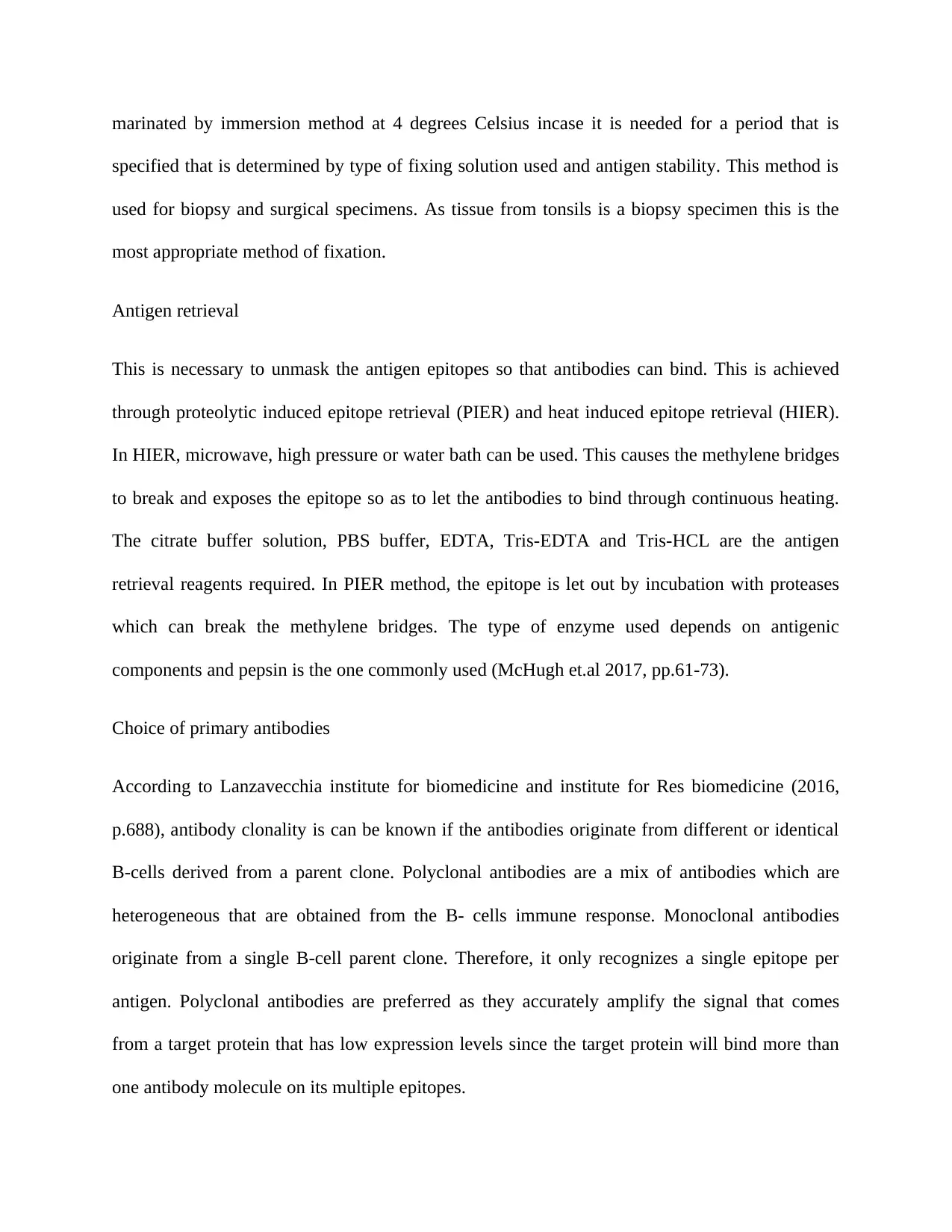
marinated by immersion method at 4 degrees Celsius incase it is needed for a period that is
specified that is determined by type of fixing solution used and antigen stability. This method is
used for biopsy and surgical specimens. As tissue from tonsils is a biopsy specimen this is the
most appropriate method of fixation.
Antigen retrieval
This is necessary to unmask the antigen epitopes so that antibodies can bind. This is achieved
through proteolytic induced epitope retrieval (PIER) and heat induced epitope retrieval (HIER).
In HIER, microwave, high pressure or water bath can be used. This causes the methylene bridges
to break and exposes the epitope so as to let the antibodies to bind through continuous heating.
The citrate buffer solution, PBS buffer, EDTA, Tris-EDTA and Tris-HCL are the antigen
retrieval reagents required. In PIER method, the epitope is let out by incubation with proteases
which can break the methylene bridges. The type of enzyme used depends on antigenic
components and pepsin is the one commonly used (McHugh et.al 2017, pp.61-73).
Choice of primary antibodies
According to Lanzavecchia institute for biomedicine and institute for Res biomedicine (2016,
p.688), antibody clonality is can be known if the antibodies originate from different or identical
B-cells derived from a parent clone. Polyclonal antibodies are a mix of antibodies which are
heterogeneous that are obtained from the B- cells immune response. Monoclonal antibodies
originate from a single B-cell parent clone. Therefore, it only recognizes a single epitope per
antigen. Polyclonal antibodies are preferred as they accurately amplify the signal that comes
from a target protein that has low expression levels since the target protein will bind more than
one antibody molecule on its multiple epitopes.
specified that is determined by type of fixing solution used and antigen stability. This method is
used for biopsy and surgical specimens. As tissue from tonsils is a biopsy specimen this is the
most appropriate method of fixation.
Antigen retrieval
This is necessary to unmask the antigen epitopes so that antibodies can bind. This is achieved
through proteolytic induced epitope retrieval (PIER) and heat induced epitope retrieval (HIER).
In HIER, microwave, high pressure or water bath can be used. This causes the methylene bridges
to break and exposes the epitope so as to let the antibodies to bind through continuous heating.
The citrate buffer solution, PBS buffer, EDTA, Tris-EDTA and Tris-HCL are the antigen
retrieval reagents required. In PIER method, the epitope is let out by incubation with proteases
which can break the methylene bridges. The type of enzyme used depends on antigenic
components and pepsin is the one commonly used (McHugh et.al 2017, pp.61-73).
Choice of primary antibodies
According to Lanzavecchia institute for biomedicine and institute for Res biomedicine (2016,
p.688), antibody clonality is can be known if the antibodies originate from different or identical
B-cells derived from a parent clone. Polyclonal antibodies are a mix of antibodies which are
heterogeneous that are obtained from the B- cells immune response. Monoclonal antibodies
originate from a single B-cell parent clone. Therefore, it only recognizes a single epitope per
antigen. Polyclonal antibodies are preferred as they accurately amplify the signal that comes
from a target protein that has low expression levels since the target protein will bind more than
one antibody molecule on its multiple epitopes.
Paraphrase This Document
Need a fresh take? Get an instant paraphrase of this document with our AI Paraphraser
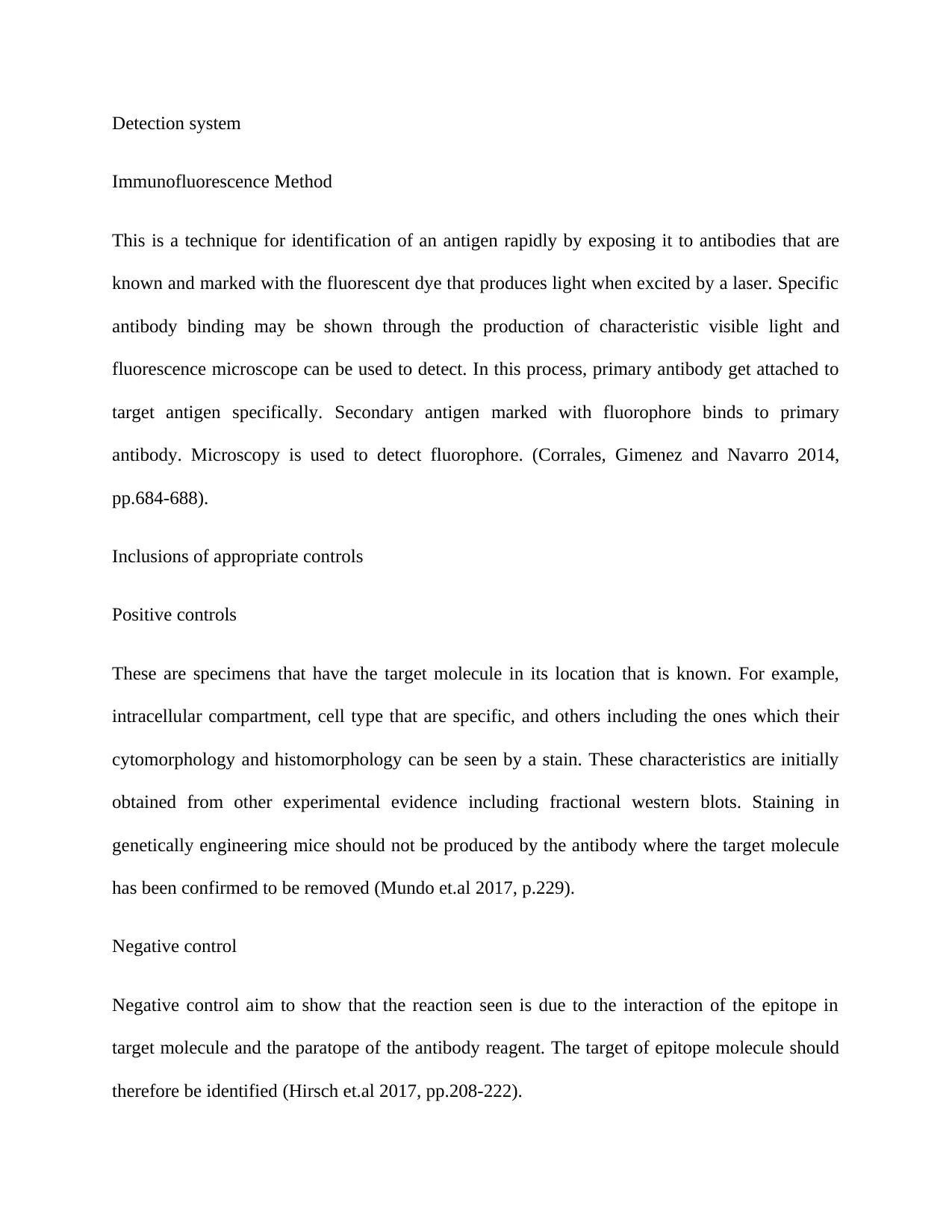
Detection system
Immunofluorescence Method
This is a technique for identification of an antigen rapidly by exposing it to antibodies that are
known and marked with the fluorescent dye that produces light when excited by a laser. Specific
antibody binding may be shown through the production of characteristic visible light and
fluorescence microscope can be used to detect. In this process, primary antibody get attached to
target antigen specifically. Secondary antigen marked with fluorophore binds to primary
antibody. Microscopy is used to detect fluorophore. (Corrales, Gimenez and Navarro 2014,
pp.684-688).
Inclusions of appropriate controls
Positive controls
These are specimens that have the target molecule in its location that is known. For example,
intracellular compartment, cell type that are specific, and others including the ones which their
cytomorphology and histomorphology can be seen by a stain. These characteristics are initially
obtained from other experimental evidence including fractional western blots. Staining in
genetically engineering mice should not be produced by the antibody where the target molecule
has been confirmed to be removed (Mundo et.al 2017, p.229).
Negative control
Negative control aim to show that the reaction seen is due to the interaction of the epitope in
target molecule and the paratope of the antibody reagent. The target of epitope molecule should
therefore be identified (Hirsch et.al 2017, pp.208-222).
Immunofluorescence Method
This is a technique for identification of an antigen rapidly by exposing it to antibodies that are
known and marked with the fluorescent dye that produces light when excited by a laser. Specific
antibody binding may be shown through the production of characteristic visible light and
fluorescence microscope can be used to detect. In this process, primary antibody get attached to
target antigen specifically. Secondary antigen marked with fluorophore binds to primary
antibody. Microscopy is used to detect fluorophore. (Corrales, Gimenez and Navarro 2014,
pp.684-688).
Inclusions of appropriate controls
Positive controls
These are specimens that have the target molecule in its location that is known. For example,
intracellular compartment, cell type that are specific, and others including the ones which their
cytomorphology and histomorphology can be seen by a stain. These characteristics are initially
obtained from other experimental evidence including fractional western blots. Staining in
genetically engineering mice should not be produced by the antibody where the target molecule
has been confirmed to be removed (Mundo et.al 2017, p.229).
Negative control
Negative control aim to show that the reaction seen is due to the interaction of the epitope in
target molecule and the paratope of the antibody reagent. The target of epitope molecule should
therefore be identified (Hirsch et.al 2017, pp.208-222).
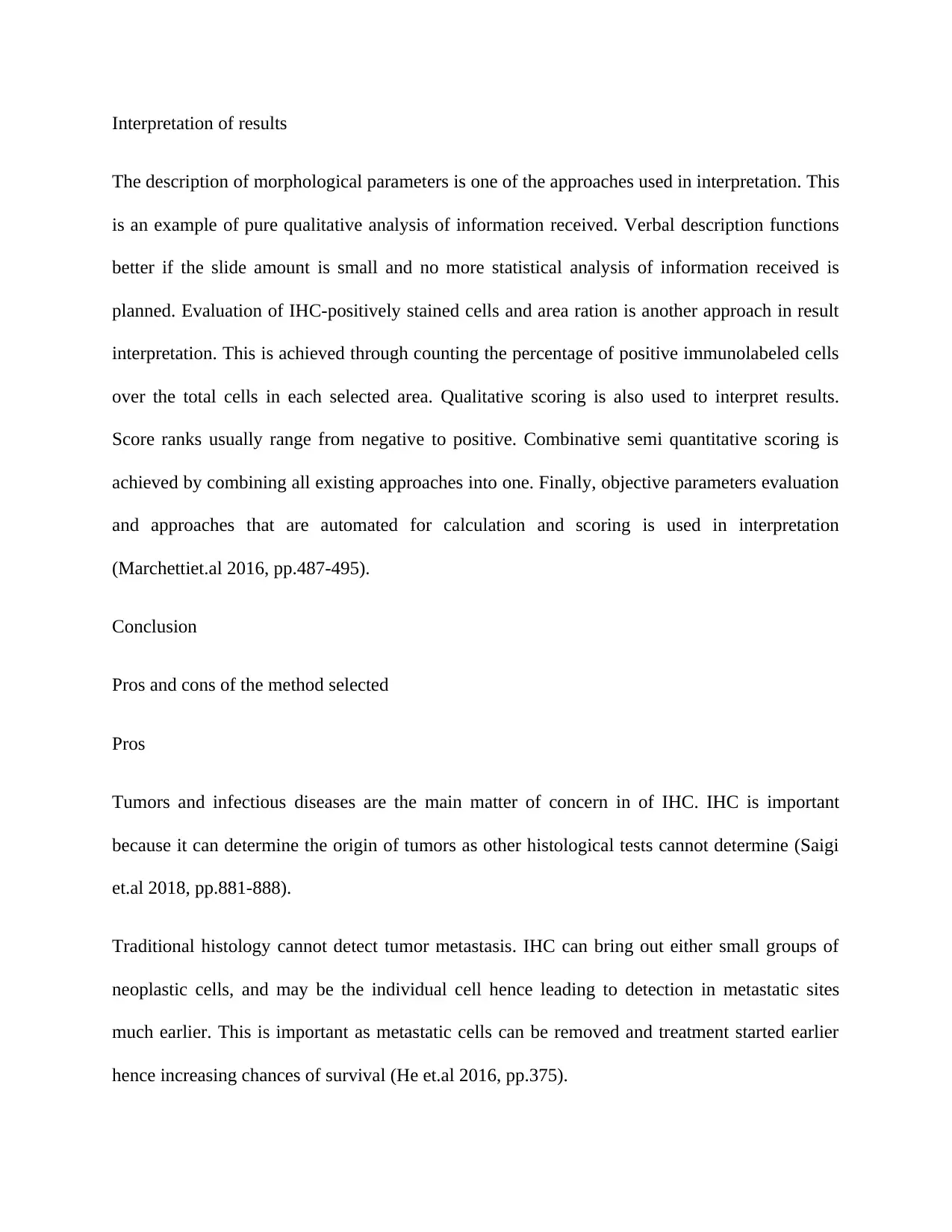
Interpretation of results
The description of morphological parameters is one of the approaches used in interpretation. This
is an example of pure qualitative analysis of information received. Verbal description functions
better if the slide amount is small and no more statistical analysis of information received is
planned. Evaluation of IHC-positively stained cells and area ration is another approach in result
interpretation. This is achieved through counting the percentage of positive immunolabeled cells
over the total cells in each selected area. Qualitative scoring is also used to interpret results.
Score ranks usually range from negative to positive. Combinative semi quantitative scoring is
achieved by combining all existing approaches into one. Finally, objective parameters evaluation
and approaches that are automated for calculation and scoring is used in interpretation
(Marchettiet.al 2016, pp.487-495).
Conclusion
Pros and cons of the method selected
Pros
Tumors and infectious diseases are the main matter of concern in of IHC. IHC is important
because it can determine the origin of tumors as other histological tests cannot determine (Saigi
et.al 2018, pp.881-888).
Traditional histology cannot detect tumor metastasis. IHC can bring out either small groups of
neoplastic cells, and may be the individual cell hence leading to detection in metastatic sites
much earlier. This is important as metastatic cells can be removed and treatment started earlier
hence increasing chances of survival (He et.al 2016, pp.375).
The description of morphological parameters is one of the approaches used in interpretation. This
is an example of pure qualitative analysis of information received. Verbal description functions
better if the slide amount is small and no more statistical analysis of information received is
planned. Evaluation of IHC-positively stained cells and area ration is another approach in result
interpretation. This is achieved through counting the percentage of positive immunolabeled cells
over the total cells in each selected area. Qualitative scoring is also used to interpret results.
Score ranks usually range from negative to positive. Combinative semi quantitative scoring is
achieved by combining all existing approaches into one. Finally, objective parameters evaluation
and approaches that are automated for calculation and scoring is used in interpretation
(Marchettiet.al 2016, pp.487-495).
Conclusion
Pros and cons of the method selected
Pros
Tumors and infectious diseases are the main matter of concern in of IHC. IHC is important
because it can determine the origin of tumors as other histological tests cannot determine (Saigi
et.al 2018, pp.881-888).
Traditional histology cannot detect tumor metastasis. IHC can bring out either small groups of
neoplastic cells, and may be the individual cell hence leading to detection in metastatic sites
much earlier. This is important as metastatic cells can be removed and treatment started earlier
hence increasing chances of survival (He et.al 2016, pp.375).
⊘ This is a preview!⊘
Do you want full access?
Subscribe today to unlock all pages.

Trusted by 1+ million students worldwide
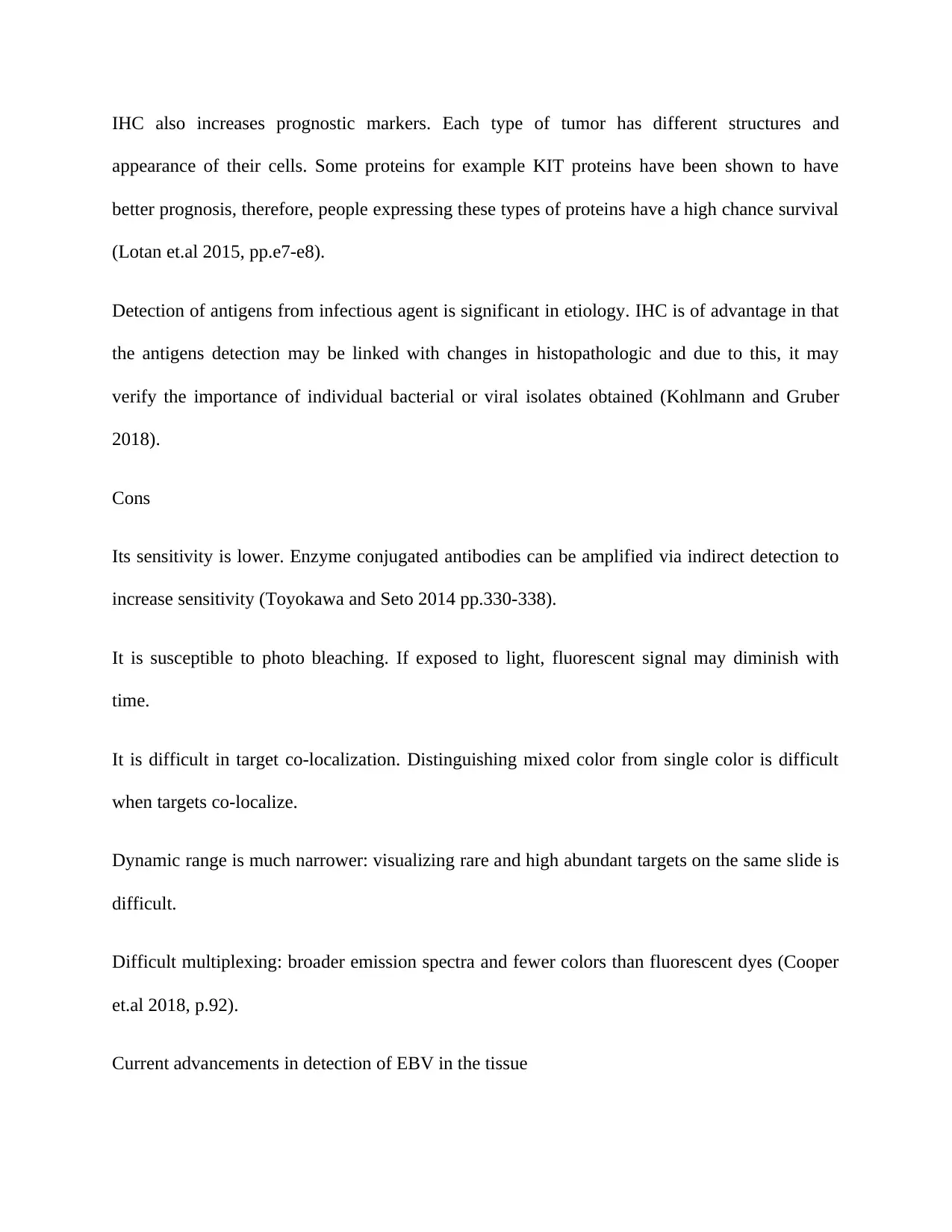
IHC also increases prognostic markers. Each type of tumor has different structures and
appearance of their cells. Some proteins for example KIT proteins have been shown to have
better prognosis, therefore, people expressing these types of proteins have a high chance survival
(Lotan et.al 2015, pp.e7-e8).
Detection of antigens from infectious agent is significant in etiology. IHC is of advantage in that
the antigens detection may be linked with changes in histopathologic and due to this, it may
verify the importance of individual bacterial or viral isolates obtained (Kohlmann and Gruber
2018).
Cons
Its sensitivity is lower. Enzyme conjugated antibodies can be amplified via indirect detection to
increase sensitivity (Toyokawa and Seto 2014 pp.330-338).
It is susceptible to photo bleaching. If exposed to light, fluorescent signal may diminish with
time.
It is difficult in target co-localization. Distinguishing mixed color from single color is difficult
when targets co-localize.
Dynamic range is much narrower: visualizing rare and high abundant targets on the same slide is
difficult.
Difficult multiplexing: broader emission spectra and fewer colors than fluorescent dyes (Cooper
et.al 2018, p.92).
Current advancements in detection of EBV in the tissue
appearance of their cells. Some proteins for example KIT proteins have been shown to have
better prognosis, therefore, people expressing these types of proteins have a high chance survival
(Lotan et.al 2015, pp.e7-e8).
Detection of antigens from infectious agent is significant in etiology. IHC is of advantage in that
the antigens detection may be linked with changes in histopathologic and due to this, it may
verify the importance of individual bacterial or viral isolates obtained (Kohlmann and Gruber
2018).
Cons
Its sensitivity is lower. Enzyme conjugated antibodies can be amplified via indirect detection to
increase sensitivity (Toyokawa and Seto 2014 pp.330-338).
It is susceptible to photo bleaching. If exposed to light, fluorescent signal may diminish with
time.
It is difficult in target co-localization. Distinguishing mixed color from single color is difficult
when targets co-localize.
Dynamic range is much narrower: visualizing rare and high abundant targets on the same slide is
difficult.
Difficult multiplexing: broader emission spectra and fewer colors than fluorescent dyes (Cooper
et.al 2018, p.92).
Current advancements in detection of EBV in the tissue
Paraphrase This Document
Need a fresh take? Get an instant paraphrase of this document with our AI Paraphraser

The recent diagnosis of EBV infections can be achieved by carrying out EBV-specific serology,
establishing spontaneous lymphoid cell lines, detecting for EBV-determined nuclear antigen in
tissues and making use of molecular hybridization techniques for showing the presence of viral
genome in the lesions that affected.
establishing spontaneous lymphoid cell lines, detecting for EBV-determined nuclear antigen in
tissues and making use of molecular hybridization techniques for showing the presence of viral
genome in the lesions that affected.
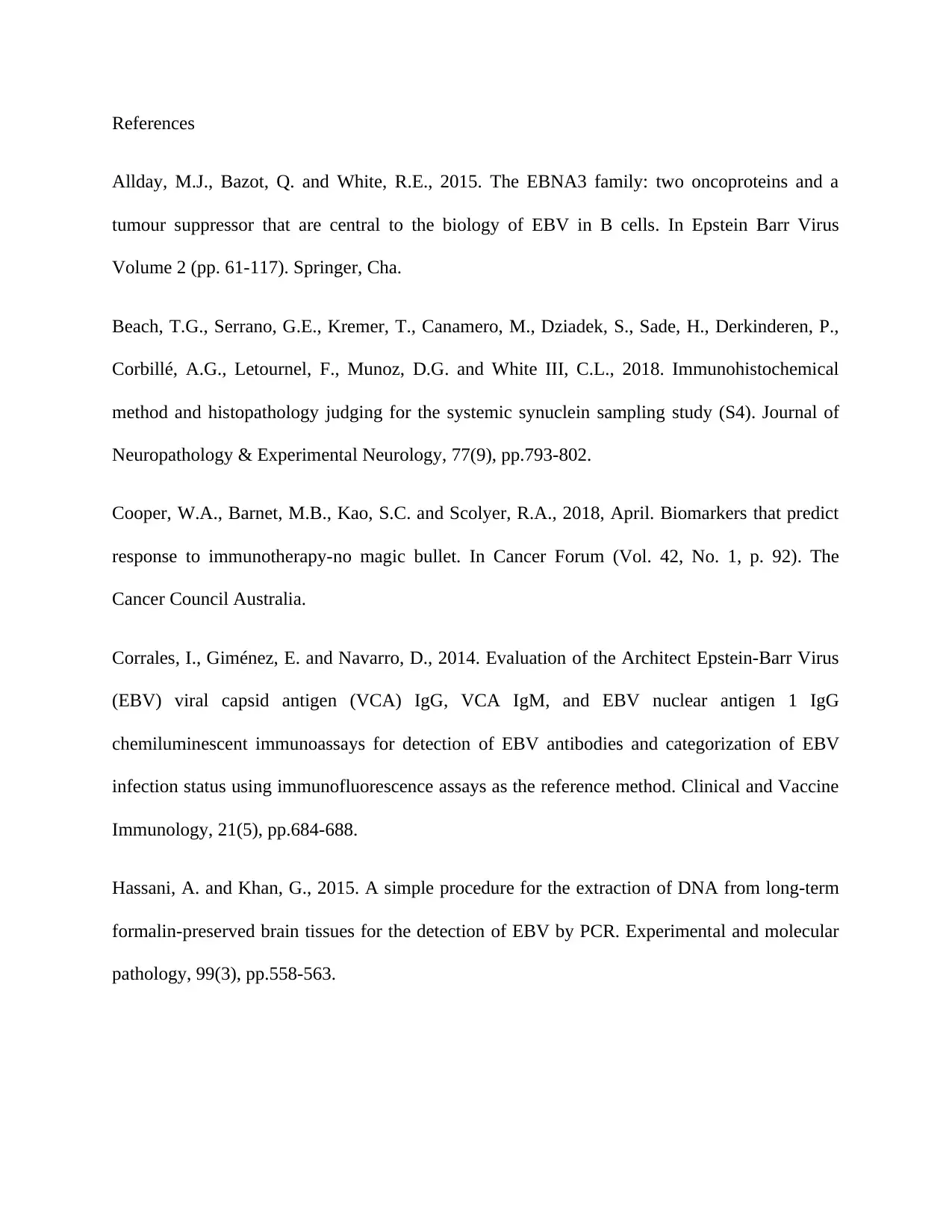
References
Allday, M.J., Bazot, Q. and White, R.E., 2015. The EBNA3 family: two oncoproteins and a
tumour suppressor that are central to the biology of EBV in B cells. In Epstein Barr Virus
Volume 2 (pp. 61-117). Springer, Cha.
Beach, T.G., Serrano, G.E., Kremer, T., Canamero, M., Dziadek, S., Sade, H., Derkinderen, P.,
Corbillé, A.G., Letournel, F., Munoz, D.G. and White III, C.L., 2018. Immunohistochemical
method and histopathology judging for the systemic synuclein sampling study (S4). Journal of
Neuropathology & Experimental Neurology, 77(9), pp.793-802.
Cooper, W.A., Barnet, M.B., Kao, S.C. and Scolyer, R.A., 2018, April. Biomarkers that predict
response to immunotherapy-no magic bullet. In Cancer Forum (Vol. 42, No. 1, p. 92). The
Cancer Council Australia.
Corrales, I., Giménez, E. and Navarro, D., 2014. Evaluation of the Architect Epstein-Barr Virus
(EBV) viral capsid antigen (VCA) IgG, VCA IgM, and EBV nuclear antigen 1 IgG
chemiluminescent immunoassays for detection of EBV antibodies and categorization of EBV
infection status using immunofluorescence assays as the reference method. Clinical and Vaccine
Immunology, 21(5), pp.684-688.
Hassani, A. and Khan, G., 2015. A simple procedure for the extraction of DNA from long-term
formalin-preserved brain tissues for the detection of EBV by PCR. Experimental and molecular
pathology, 99(3), pp.558-563.
Allday, M.J., Bazot, Q. and White, R.E., 2015. The EBNA3 family: two oncoproteins and a
tumour suppressor that are central to the biology of EBV in B cells. In Epstein Barr Virus
Volume 2 (pp. 61-117). Springer, Cha.
Beach, T.G., Serrano, G.E., Kremer, T., Canamero, M., Dziadek, S., Sade, H., Derkinderen, P.,
Corbillé, A.G., Letournel, F., Munoz, D.G. and White III, C.L., 2018. Immunohistochemical
method and histopathology judging for the systemic synuclein sampling study (S4). Journal of
Neuropathology & Experimental Neurology, 77(9), pp.793-802.
Cooper, W.A., Barnet, M.B., Kao, S.C. and Scolyer, R.A., 2018, April. Biomarkers that predict
response to immunotherapy-no magic bullet. In Cancer Forum (Vol. 42, No. 1, p. 92). The
Cancer Council Australia.
Corrales, I., Giménez, E. and Navarro, D., 2014. Evaluation of the Architect Epstein-Barr Virus
(EBV) viral capsid antigen (VCA) IgG, VCA IgM, and EBV nuclear antigen 1 IgG
chemiluminescent immunoassays for detection of EBV antibodies and categorization of EBV
infection status using immunofluorescence assays as the reference method. Clinical and Vaccine
Immunology, 21(5), pp.684-688.
Hassani, A. and Khan, G., 2015. A simple procedure for the extraction of DNA from long-term
formalin-preserved brain tissues for the detection of EBV by PCR. Experimental and molecular
pathology, 99(3), pp.558-563.
⊘ This is a preview!⊘
Do you want full access?
Subscribe today to unlock all pages.

Trusted by 1+ million students worldwide
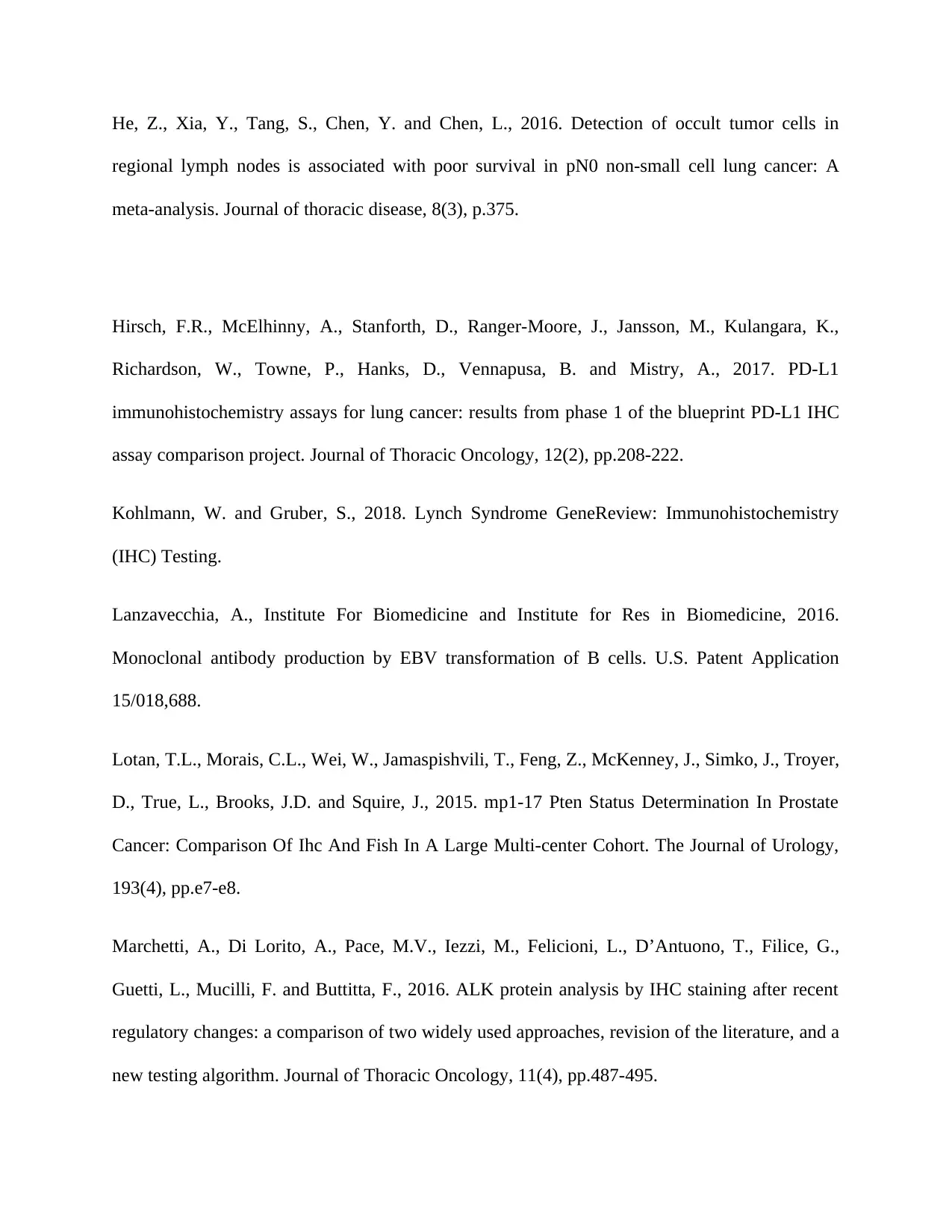
He, Z., Xia, Y., Tang, S., Chen, Y. and Chen, L., 2016. Detection of occult tumor cells in
regional lymph nodes is associated with poor survival in pN0 non-small cell lung cancer: A
meta-analysis. Journal of thoracic disease, 8(3), p.375.
Hirsch, F.R., McElhinny, A., Stanforth, D., Ranger-Moore, J., Jansson, M., Kulangara, K.,
Richardson, W., Towne, P., Hanks, D., Vennapusa, B. and Mistry, A., 2017. PD-L1
immunohistochemistry assays for lung cancer: results from phase 1 of the blueprint PD-L1 IHC
assay comparison project. Journal of Thoracic Oncology, 12(2), pp.208-222.
Kohlmann, W. and Gruber, S., 2018. Lynch Syndrome GeneReview: Immunohistochemistry
(IHC) Testing.
Lanzavecchia, A., Institute For Biomedicine and Institute for Res in Biomedicine, 2016.
Monoclonal antibody production by EBV transformation of B cells. U.S. Patent Application
15/018,688.
Lotan, T.L., Morais, C.L., Wei, W., Jamaspishvili, T., Feng, Z., McKenney, J., Simko, J., Troyer,
D., True, L., Brooks, J.D. and Squire, J., 2015. mp1-17 Pten Status Determination In Prostate
Cancer: Comparison Of Ihc And Fish In A Large Multi-center Cohort. The Journal of Urology,
193(4), pp.e7-e8.
Marchetti, A., Di Lorito, A., Pace, M.V., Iezzi, M., Felicioni, L., D’Antuono, T., Filice, G.,
Guetti, L., Mucilli, F. and Buttitta, F., 2016. ALK protein analysis by IHC staining after recent
regulatory changes: a comparison of two widely used approaches, revision of the literature, and a
new testing algorithm. Journal of Thoracic Oncology, 11(4), pp.487-495.
regional lymph nodes is associated with poor survival in pN0 non-small cell lung cancer: A
meta-analysis. Journal of thoracic disease, 8(3), p.375.
Hirsch, F.R., McElhinny, A., Stanforth, D., Ranger-Moore, J., Jansson, M., Kulangara, K.,
Richardson, W., Towne, P., Hanks, D., Vennapusa, B. and Mistry, A., 2017. PD-L1
immunohistochemistry assays for lung cancer: results from phase 1 of the blueprint PD-L1 IHC
assay comparison project. Journal of Thoracic Oncology, 12(2), pp.208-222.
Kohlmann, W. and Gruber, S., 2018. Lynch Syndrome GeneReview: Immunohistochemistry
(IHC) Testing.
Lanzavecchia, A., Institute For Biomedicine and Institute for Res in Biomedicine, 2016.
Monoclonal antibody production by EBV transformation of B cells. U.S. Patent Application
15/018,688.
Lotan, T.L., Morais, C.L., Wei, W., Jamaspishvili, T., Feng, Z., McKenney, J., Simko, J., Troyer,
D., True, L., Brooks, J.D. and Squire, J., 2015. mp1-17 Pten Status Determination In Prostate
Cancer: Comparison Of Ihc And Fish In A Large Multi-center Cohort. The Journal of Urology,
193(4), pp.e7-e8.
Marchetti, A., Di Lorito, A., Pace, M.V., Iezzi, M., Felicioni, L., D’Antuono, T., Filice, G.,
Guetti, L., Mucilli, F. and Buttitta, F., 2016. ALK protein analysis by IHC staining after recent
regulatory changes: a comparison of two widely used approaches, revision of the literature, and a
new testing algorithm. Journal of Thoracic Oncology, 11(4), pp.487-495.
Paraphrase This Document
Need a fresh take? Get an instant paraphrase of this document with our AI Paraphraser
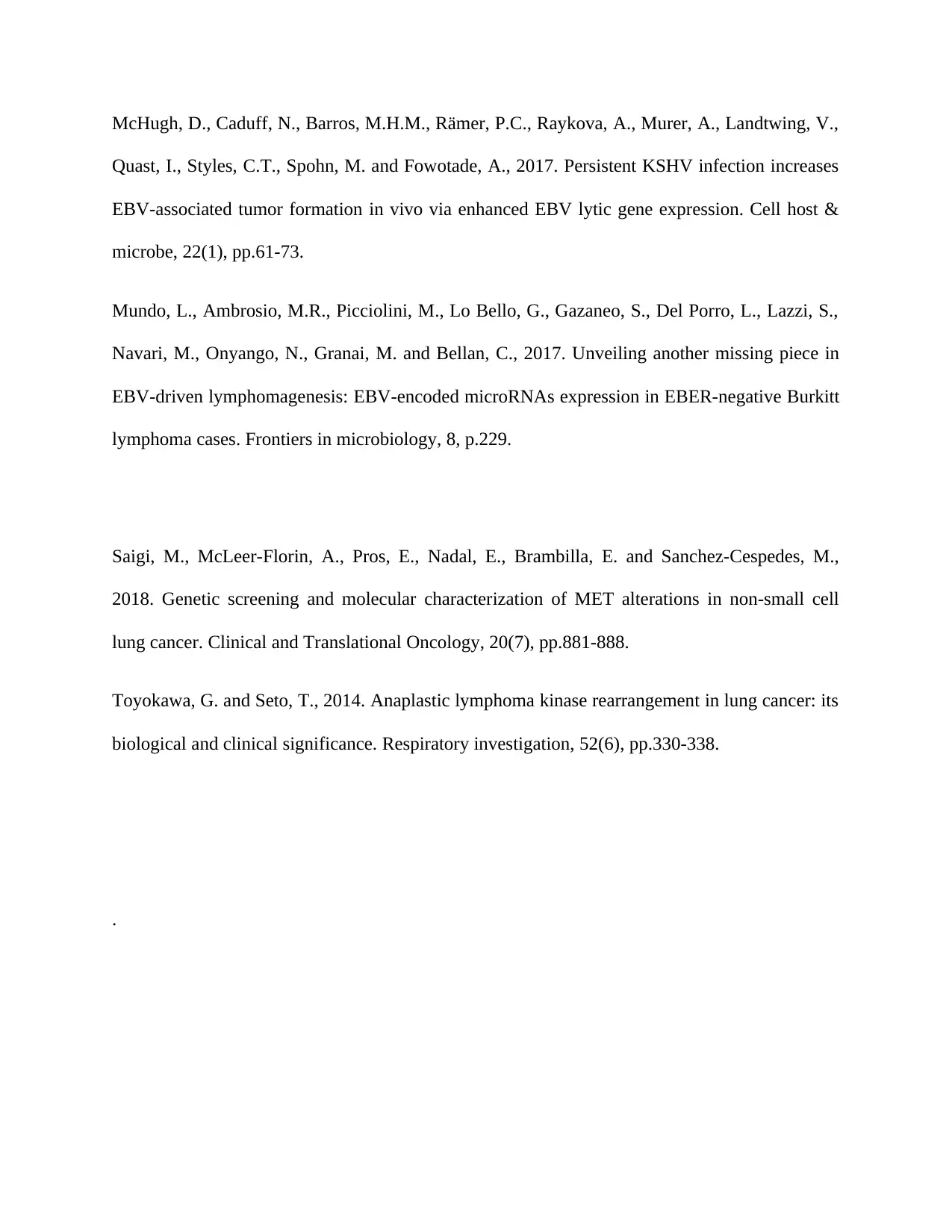
McHugh, D., Caduff, N., Barros, M.H.M., Rämer, P.C., Raykova, A., Murer, A., Landtwing, V.,
Quast, I., Styles, C.T., Spohn, M. and Fowotade, A., 2017. Persistent KSHV infection increases
EBV-associated tumor formation in vivo via enhanced EBV lytic gene expression. Cell host &
microbe, 22(1), pp.61-73.
Mundo, L., Ambrosio, M.R., Picciolini, M., Lo Bello, G., Gazaneo, S., Del Porro, L., Lazzi, S.,
Navari, M., Onyango, N., Granai, M. and Bellan, C., 2017. Unveiling another missing piece in
EBV-driven lymphomagenesis: EBV-encoded microRNAs expression in EBER-negative Burkitt
lymphoma cases. Frontiers in microbiology, 8, p.229.
Saigi, M., McLeer-Florin, A., Pros, E., Nadal, E., Brambilla, E. and Sanchez-Cespedes, M.,
2018. Genetic screening and molecular characterization of MET alterations in non-small cell
lung cancer. Clinical and Translational Oncology, 20(7), pp.881-888.
Toyokawa, G. and Seto, T., 2014. Anaplastic lymphoma kinase rearrangement in lung cancer: its
biological and clinical significance. Respiratory investigation, 52(6), pp.330-338.
.
Quast, I., Styles, C.T., Spohn, M. and Fowotade, A., 2017. Persistent KSHV infection increases
EBV-associated tumor formation in vivo via enhanced EBV lytic gene expression. Cell host &
microbe, 22(1), pp.61-73.
Mundo, L., Ambrosio, M.R., Picciolini, M., Lo Bello, G., Gazaneo, S., Del Porro, L., Lazzi, S.,
Navari, M., Onyango, N., Granai, M. and Bellan, C., 2017. Unveiling another missing piece in
EBV-driven lymphomagenesis: EBV-encoded microRNAs expression in EBER-negative Burkitt
lymphoma cases. Frontiers in microbiology, 8, p.229.
Saigi, M., McLeer-Florin, A., Pros, E., Nadal, E., Brambilla, E. and Sanchez-Cespedes, M.,
2018. Genetic screening and molecular characterization of MET alterations in non-small cell
lung cancer. Clinical and Translational Oncology, 20(7), pp.881-888.
Toyokawa, G. and Seto, T., 2014. Anaplastic lymphoma kinase rearrangement in lung cancer: its
biological and clinical significance. Respiratory investigation, 52(6), pp.330-338.
.

Veroni, C., Serafini, B., Rosicarelli, B., Fagnani, C. and Aloisi, F., 2018. Transcriptional profile
and Epstein-Barr virus infection status of laser-cut immune infiltrates from the brain of patients
with progressive multiple sclerosis. Journal of neuroinflammation, 15(1), p.18.
and Epstein-Barr virus infection status of laser-cut immune infiltrates from the brain of patients
with progressive multiple sclerosis. Journal of neuroinflammation, 15(1), p.18.
⊘ This is a preview!⊘
Do you want full access?
Subscribe today to unlock all pages.

Trusted by 1+ million students worldwide
1 out of 12
Your All-in-One AI-Powered Toolkit for Academic Success.
+13062052269
info@desklib.com
Available 24*7 on WhatsApp / Email
![[object Object]](/_next/static/media/star-bottom.7253800d.svg)
Unlock your academic potential
Copyright © 2020–2025 A2Z Services. All Rights Reserved. Developed and managed by ZUCOL.
